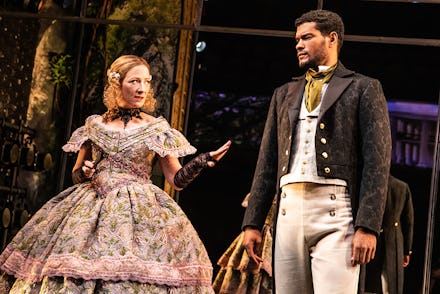'Slave Play' is the only thing from 2019 I'll remember

In a video circulating online, a white woman at a production of Slave Play has a certifiable meltdown. Jeremy O. Harris’ bombshell work, which centers on interracial couples in an experimental form of counseling that involves antebellum role-play, had its Broadway debut in September and premiered off-Broadway last year. Early reviews heralded its fearlessness in the face of ideas like racialized desire, kink, and power. Some found it uncomfortably loose with imagery of slavery. The exchange with the unnamed white woman took place during a Q+A with Harris last week. At one point, in an expression of frustration at what she viewed as the play’s flattening of white people’s experiences, the woman revealed her own challenges with sexual assault and her children’s custody. "How the fuck am I not a fucking marginalized member of this goddamn society?" she shouted.
Harris kept calm. “I never once said that you as a white woman were not a marginalized person,” he told her. “But if you heard that in my play, I don’t know what to tell you. Perhaps read it or see it again.”
Since seeing Slave Play a few months ago, I’ve wanted only to heed this last bit of advice. The production has infected my thinking in a way that I haven’t been able to shake. There is me before seeing Slave Play and me after, shifted imperceptibly towards an understanding that feels exhilarating and distressingly unfamiliar. The night I saw the play, in October, a white woman stopped me outside the theater to tell me how powerful she thought it was. The exchange was decidedly cordial in contrast to the episode that took place last week, but I was with a friend who pointed out how odd it seemed that this woman sought me, a black man, out to tell me this.
But when I think of it, I can locate her impulse. Slave Play makes white people face themselves as something other than a default. Through the eyes of Black people who, sometimes despite themselves, choose to love them. The feigned ignorance of liberal whites who “don’t see color” is refracted through the play’s lens — not to mention an actual mirror facing the audience, courtesy of set designer Clint Ramos — to what I can only imagine is a disorienting effect.
Harris is also no blunderbuss. There are no villains and victims as much as there are quiet and painful gaps in empathy. Disconnects that compound endlessly until things become intractably bleak.
Directed by Robert O’Hara, Slave Play’s first act opens with a pitch modified version of Rihanna’s single “Work.” We’re introduced to Kaneisha, a slave on a plantation dancing while she labors in the sun. A white man, Jim, enters and before long an uncomfortable sexual tension builds. He has her eat fruit from off the ground. He calls her “negress.” It is instructive to consider some critics’ discomfort with Slave Play’s toying with slave and master sexual dynamics considering the violent legacy of rape in the antebellum south.
As the act progresses we meet Phillip, a black servant to a wealthy white heiress named Alana, whose husband is away, and whose physical obsession with Phillip lends itself to both slapstick and unsettling considerations of gender, race, and power. Finally, the play's only LGBT pair, Gary and Dustin, play out a master-slave dynamic which finds itself reversed back and forth until an emotional climax sets the stage for the second half of the production, where we learn that all of these vignettes were part of something called “Antebellum Sexual Performance Therapy.”
Without giving too much away, it is the therapy, not the titular “slave play” that’s hardest to sit through. We see our trio of couples, now wearing more modern attire, sexually frustrated and confused. “Antebellum Sexual Performance Therapy" is supposed to help Black people re-connect with their white partners. The backstory for each of the play's couples is a prolonged period of sexual dysfunction. The wrinkle is how ludicrous “Antebellum Sexual Performance Therapy” ultimately is. The two doctors leading the therapy, a lesbian couple whose subtle bickering is as instructive as any easter egg, cling to the therapy's efficacy for their own relationship's sake. And that's where Slave Play nestles in my thoughts without letting go. To read the production as a rebuke of interracial coupling is a dramatically daft interpretation. So, too, is overlooking the impossible conundrums the play presents.
One thing that is clear is the deep sense of loneliness endured by the play's Black characters. Your heart hurts for Kaneisha, who in a powerful soliloquy condemns Jim as a "virus." The colonial undertones are hard to ignore, and in this context even more pervasive. She recalls meeting Jim and feeling overcome by his recognition. Here, again, Harris is quite delicate. We're made to understand why Kaneisha would feel validated by the gaze of a white man. And beyond pitying or condemning her for doing so, or even rebuking Jim for his part, we're left only with the painfulness of that experience. The deep and confounding isolation of looking for recognition in someone who might never actually see you.